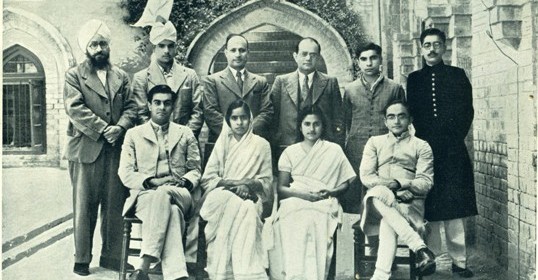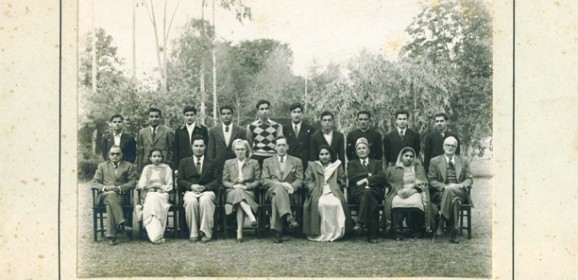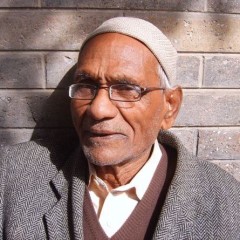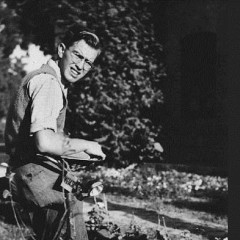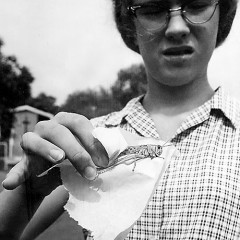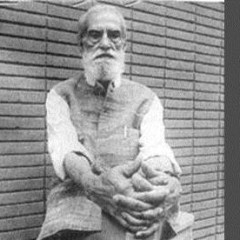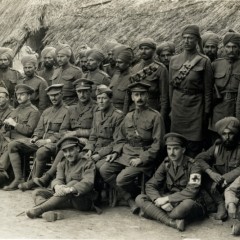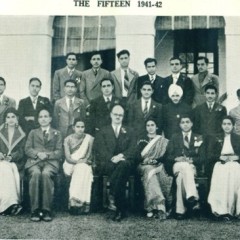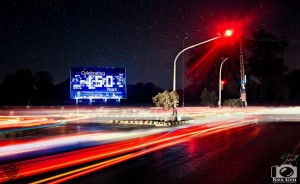Naseer Ahmed, the College Barber
Naseer Ahmed, the famous college barber, is part and parcel of FCC. He was a young man when he came from Dehra Dun (India) looking for a job and has spent most of his life here. He and his elder brother Shafiq started this barbershop in 1945. Now he is about 77 years old and runs the shop with his son Muhammad Idrees. He has a vivid and sharp memory of the past, which he calls a golden time. Lean and talkative, he speaks non-stop in a raspy voice about his past. You have to interrupt him to bring him to the present. He proudly announces that he has given a haircut to all the “Barey Sahibs” of this campus since 1945. All the teachers and students know him and he has been their hair stylist at some time or the other. Name any famous alumni of FCC, and he usually knows them and says “Those were great people – you can’t find such people nowadays.” He had the privilege of playing basketball with Dr S L Sheets in his younger days and played at the position of defender. He won matches and gained popularity with students and teachers. He remembers the treats given by Dr Sheets at the campus canteen after the matches. Past memories brings a spark into his old eyes. A loyal and devoted worker of FCC, he wants to continue working at the campus for the remaining part of his life. A brief interview was recorded with him. Naseer, how do you see the time now compared to the old days? The time has changed fast. Not that the people are not loving and caring, but now people don’t have the time to spare to sit together. They have isolated themselves and are completely absorbed in their own life. Can you give us some example? Yes. I used to go very regularly to the residence of Dr Sinclair for his haircut. We used to have discussions and he never let me return without a cup of tea. He was very particular about time. Once I was late by fifteen minutes and he asked me to go back and come the next day. That day I had borrowed a watch from someone, which gave the wrong time. Dr Sinclair was a man of principle. I remember that he turned out his son “Putty” from the college when he saw him smoking outside Velte Hall. Dr Sinclair was both the Principal of the college and warden of Velte Hall. His son went to England and joined the Royal Air Force. You were a good basketball player and...
An American in India
…Which brings me to the label of “American Indian”. Well, why not? My parents were American, but India was the land of my birth. I was conceived, born in 1925, and nurtured in the Bengal railway colony of Kharagpur, almost as a kind of affirmation by my parents that the family- which included my Pennsylvania-born older brother- was now Indian as well as American. My brother had arrived in Kharagpur with my parents in 1923, as a four-year old. My sister rounded out our family roster with her birth in Kharagpur three years after mine. It was Indian air that filled my lungs as I inhaled and bellowed for the first time, and it was produce of the Indian soil that nourished me through infancy and childhood. My Indian ayah watched, bathed, dressed, fed, and put me to sleep under mosquito net with Indian lullabies, and it was in her arms that I spoke my first word, chand, an Indian word, while pointing at the moon. The passport amendment bearing my name in my parents’ passport said “American,” but in so many other important respects, I was Indian. So what is my label? Probably not any one of these. It depends upon how one feels at any given time. But there was one revealing experience at the outset of my teaching career at Forman Christian College in Lahore, formerly in India, now in Pakistan. It was the first day of class at the opening of the fall term. I entered the room. The students, most of whom were wearing the dark-blue FCC blazer, all stood until I took my place at the front and gave them permission to sit. I called the roll without too much difficulty. The boys listened with what seemed to be a flattering degree of attention. All went well and the class ended. At that point I was surrounded by a circle of smiling young Punjabi and Anglo-Pakistani (formerly Anglo-Indian) men, one of whom said, “Sir, we are so happy. You are the only American we can understand!” What better endorsement of my identity could there ever have been than this?… Text source: American Indian in Kharagpur: Exploring a Personal Brand Name by Stanley E Brush, published in The Way We Were: Anglo-Indian Chronicles Images source: www.dadinani.com Note: According to http://www.dadinani.com/capture-memories/read-contributions/life-back-then/140-american-boyhood-british-india: After Stanley completed graduate work in sociology and religion, and Beverly [his wife] finished her nursing degree, they moved with their two young daughters, Cynthia and Victoria, to Lahore, Pakistan in 1952. Stan taught English and History at Forman Christian College and Punjab University. Beverly worked at United Christian Hospital. In 1963, Stan moved with his family to...
The Day of the Locusts
Locusts swarm over Forman Christian College campus hockey fields, Lahore Pakistan (1962) …I’d like to share an “outside-in” perspective on my childhood that was similar in many ways to the Anglo-Indian experience during the first half of the twentieth century. My parents moved to West Pakistan, the western portion of this new country, in 1952, a short five years after Partition. It was to be my childhood home for a decade. My sister hadn’t even reached her first birthday. I was an impressionable, curious, but less than cooperative two-year-old… …We lived in several places. Our first home was in the dusty rural village of Raiwand, connected to the rest of the world by the railroad, and to other villages by worn footpaths alongside the canal banks and rutted roads etched into the earth by heavily-laden bullock carts. Within a year’s time, we moved to Forman Christian College, a well regarded, men’s private educational institution, in the vibrant city of Lahore. My father taught English before finding his niche as a history professor. My mother employed her nursing skills by volunteering to keep United Christian Hospital patients’ charts and record up-to-date—each one written entirely by hand… …We experienced the locust swarms, spring of 1962. They descended over Lahore’s Forman Christian College campus like a swirling dust storm. My sister and I, my folks as well, dashed up to the second story verandah to have a locust’s eyeview of the green lawns, trees and hockey fields beyond the eucalyptus row and hedge. Mom recalls “bugs being everywhere.” Victoria remembers “going up on the roof…and banging pots with spoons,” which the wise adults informed us would deter the ravenous locusts – a type of huge grasshopper – from devouring the sports fields and denuding trees. (From my mature vantage point as an enthused gardener, the veracity of this practice seems dubious.) I do recall great excitement among the household adults, staff and my folks alike….a mix of anticipation and alarm….with little comprehension on my part for its basis. I also remember watching more experienced Pakistanis chasing them off the lawns and knocking quantities of locusts out of the sky and with big colorful cotton cloths. After 48 intervening years, none of us can recall if there was much damage done. Cynthe’s love of animals doesn’t extend to locusts (1962) Our family of four sat in designated places for dinner as usual. Sunlight slanting through the tall windows behind my back as we waited for the meal to be served. At some point, our cook and bearer from #15 (our house on the FCC campus) proudly brought us a heaping plateful of...
Birth of Lahore College of Art
…I also found the studio of art legend Bhabesh Chandra Sanyal, also known as B.C. Sanyal, who gave a new stroke to Indian art. Sanyal, born on 22nd April 1901, is the guru of the art of the undivided Indian sub-continent. In 1937, he set up a studio in the premises of the Forman Christian College, which later became an art school… (This school later came to be known as the Lahore College of Art) …A few years later, the Lahore College of Art was shifted to the Dayal Singh Mansions of the city, after Sanyal received a positive response and a huge turnout of the most popular artistes when he held an exhibition in the basement of the building. Sanyal remained as the teacher at the Lahore College of Art until India’s independence in 1947, after which he permanently migrated to Delhi… Text source 1: From Amrita Shergil to Lady Harrison: A Journey Through History, published in Dawn.com by Ali Zaef Text source 2: World Famous Great Painters by Vikas Khatri Image source: www.tribuneindia.com Note 1: Bhabesh Chandra Sanyal was an eminent painter more widely known as the Grand Old Man of Indian art. His preferred medium was watercolors through which he depicted rural life and the struggles of ordinary people among...
First Formanite to win MC
Between the years 1889 and 1902 Indrajit Singh, the son of Raja Sir Harnam Singh, was a student of the College. Subsequently he went to Cambridge and took his degree in medicine and was appointed to the Indian Medical Service. Early in 1914 he was attached to the 57th Wildes Rifles and when the War broke out he accompanied the regiment to France. In November 1914, he was killed in action and was buried at Bethune, where the writer of this account visited his grave. For his gallant conduct in the filed he was awarded, posthumously, the Military Cross. The College Magazine for November 1914, gives an account of the Memorial Service held in the Hall. His memory is kept alive in the College by an endowed scholarship, known as the Indrajit Singh Scholarship, which was founded by his father and is awarded to a Christian student preparing himself for the profession of medicine. During the War two other former students won military distinction and were awarded the Military Cross. Text: S. K. Datta’s “The History of the Forman Christian College: Selections from the Records of the College 1869-1936”. Image: Photograph by H. D. Girdwood (1878-1964) of British and Indian officers of the 57th [Wilde’s] Rifles taken on 6 August 1915. In the possession of the British Library. http://commons.wikimedia.org/wiki/File:British_and_Indian_officers_of_the_57th_Wildes_Rifles_(Photo_24-277).jpg Note 1: According to the Commonwealth War Graves Commission (www.cwgc.org), Capt. Kanwar Indrajit Singh of the Indian Medical Service died on 24 November 1914 and is buried in grave 1. A. 23. in Bethune Town Cemetery, France. Note 2: Capt. Dr. Indrajit Singh MC was not the only son of Raja Sir Harnam Singh to attend FCC. According to http://www.royalark.net/India/kapurth3.htm, at least three more of his sons were Formanites: Raja Raghubir Singh, OBE (c 3.6.1919). b. at Kapurthala Palace, Badshah Bagh, Lucknow, 3rd May 1876, educ. Harrow Sch, Mdsx and Forman Christian Coll, Lahore. Joined the ICS, Asst Cmsnr Punjab 1902, Deputy Collector Ludhiana. Succeeded to the title of Raja on the death of his father, 20th May 1930. Rcvd: Delhi Durbar silver medal (1911). The Hon Kunwar Sir Dalip Singh. b. at Kapurthala Palace, Badshah Bagh, Lucknow, 2nd June 1885, educ. Forman Christian Coll, Lahore, Pembroke Coll, Cambridge (BA), and Lincoln’s Inn, London. Barr-at-Law in private practice at the Lahore High Court 1912-1926, Sec Punjab Legislative Assembly 1921-1922, Assist Legal Remembrancer Punjab 1922-1924, Advocate-Gen Punjab 1924-1925, Additional Judge Lahore 1926-1930, Puisne Judge Lahore High Court 1930-1943, Presiding Officer of the Judicial Cttee and Judicial Adviser for the Mandi, Suket and Simla Hill States 1943-1946, Chair UN Cttee on the Progressive Development of International Law and its Codification 1946-1947, Legal & Treaties...
Founding of “The Fifteen”
Mowbray Velte first came to this country when he was hardly one year old in 1894, and then as a short termer in 1915, the youngest and handsomest member of the Forman Christian Staff, hardly distinguishable in age, appearance and temperament and activities from his pupils with whom he mixed so freely. During his brief stay of three or four years he founded the famous ‘Fifteen’ the premier literary society of the college and the province. Among the first members of the ‘Fifteen’ were distinguished gentlemen like Shi Gulzari Nanda, Mr D. K. Sen both of them holding supreme positions in India as senior member of Pandit Jawahar Lal Nehru’s cabinet and Prime Minister of Patiala respectively, Principal Khanna, A. N. Das Gupta, C. L. Aggarwal and myself and the deceased Mr Mohammad Aslam, Income-Tax Commissioner and S. Kartar Singh Advocate. The ‘Fifteen’ founded in 1916-1917 has continued now for more than forty-five years. The idea behind the founding of the ‘Fifteen’ was the revival of the traditions and achievements of the Literary Club, founded by Dr. Johnson during the eighteenth century of which he was the Founder-Dictator and Garrick, Sir Joshua Reynolds, Goldsmith Boswell and Edmund Burke were the distinguished members. The ‘Fifteen’ has produced quite a galaxy of eminent scholars, statesmen, poets and men of letters. Dr Velte had something of the great Dr Johnson about him. His charming personality, his love of the best that has been thought and written and his first hand knowledge of the latest and most ancient classics in art and literature. The members of the ‘Fifteen’ were equally at home in classical literature as well as the Roman and the great apostles and pioneers of modern literature. We liberally surveyed the extensive domains of literature from China to Peru, that is, from Geoffrey Chaucer to Oscar Wilde and from Oscar Wilde to Pearl Buck. Leonard Da Vinchi, Rembrandt, Goethe, Tolstoi, Tagore and Iqbal were exhaustively discussed and criticized at these meetings. Dr Velte was the soul of the whole assembly that met each fortnight and Mrs Velte our chief hostess and patron. None who has been a ‘Fifteener’ can forget those meetings and fruitful and creative discussions. Some of the most distinguished members of the Bar, the Bench, the Civil Services and even those who are in the cabinet on both sides enjoyed this rare privilege and are really proud of it. Mr Mumtaz Hasan, Finance Secretary, Mr Wazir Ali another Finance Secretary; Mr Ata Ullah Kalim, Chief Controller, Military Accountant, Principal M. M. Anwar and great many of the younger and older members of the Pakistan Civil Service and...

